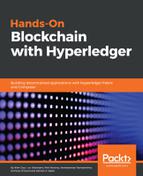As you already know by now, an instance of a Hyperledger Fabric blockchain is referred to as a channel, which is a log of transactions linked to each other in a cryptographically secure manner. To design and run a blockchain application, the first step is to determine how many channels are required. For our trade application, we will use one channel, which will maintain the history of trades carried out among the different participants.
Before we delve into the mechanics of setting up our system to install an application and run transactions on our smart contract, we will describe how to create and launch a network on which the application will be installed. A sample network structure will be used to illustrate trade operations throughout this chapter (in Chapter 9, Life in a Blockchain Network, you will see how this sample network can be modified as the requirements change and evolve).
